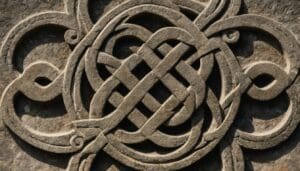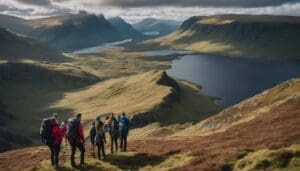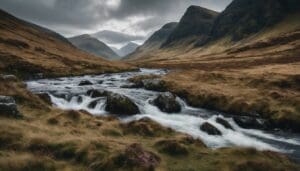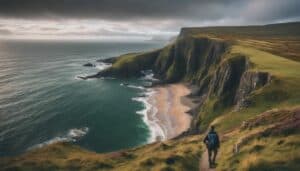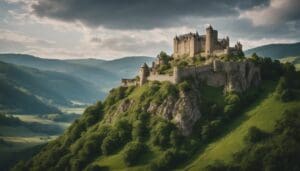The Names of Ireland’s 32 Counties Explained – The Ultimate Guide to Ireland’s County Names
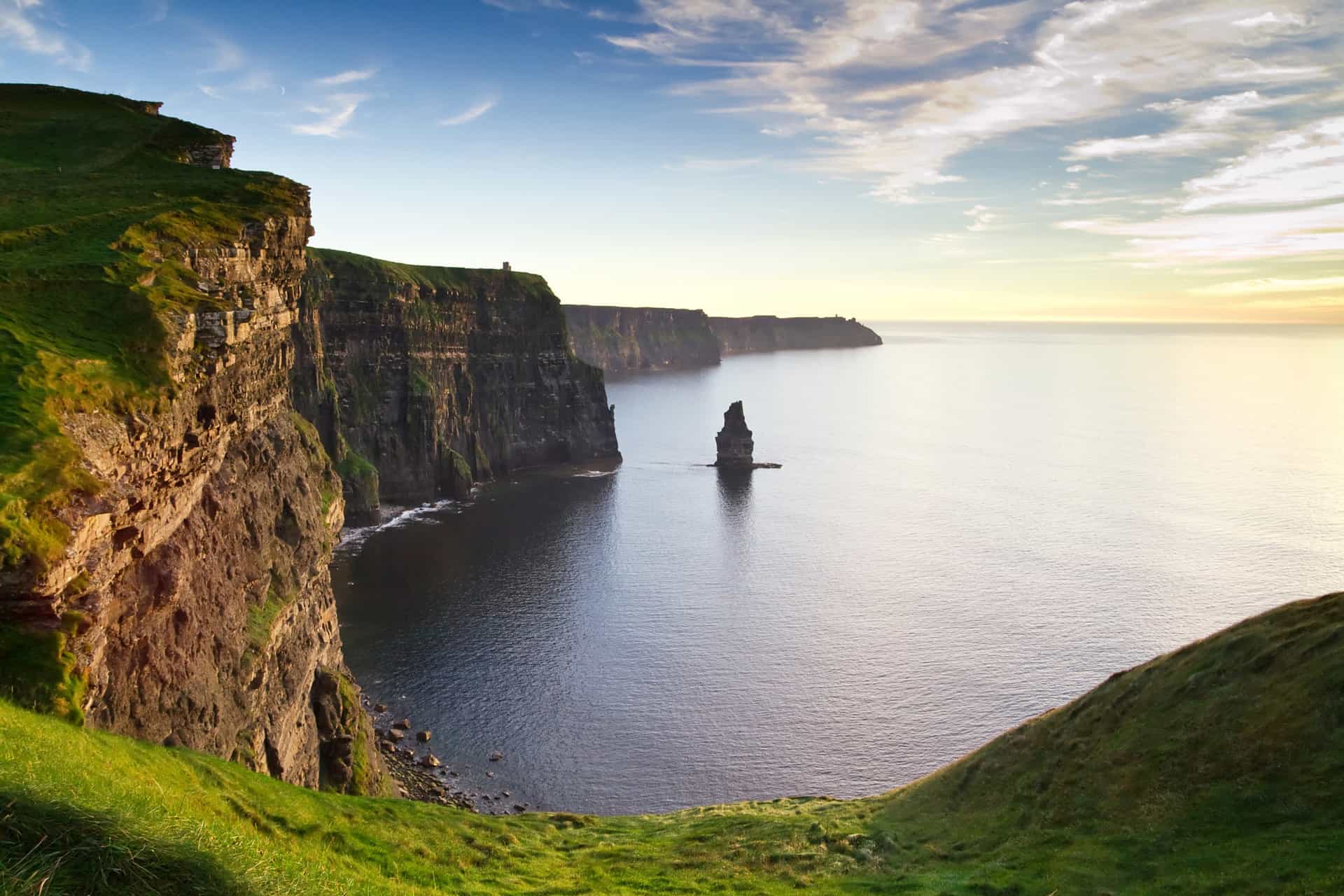
Updated On: April 16, 2024 by Ciaran Connolly
You probably know that Ireland’s village, town and county names derive from Irish or Gaelic origin, but did you know that these place names are shrouded in Celtic mythology, ancient geography and so much more?
The county names that we use today are Anglicised versions of traditional Irish place names. That means that each county actually has an English translation that tells us more about what it used to look like, or even more interestingly, who used to live there.
In this article we will discuss the etymology of the 32 counties on the island of Ireland. Before we start explaining the name of each individual county it is important to understand how the emerald isle is divided up. There are 4 provinces in Ireland; Ulster in the North, Leinster in the East, Munster in the South and Connacht in the West.
Why not skip ahead to a certain section in our article:
- The Four Provinces of Ireland
- Ulster County names meaning
- Leinster County names meaning
- Munster County names meaning
- Connacht County names meaning
There are 26 counties in the Republic of Ireland, and 6 counties in Northern Ireland. Ulster contains the 6 counties in Northern Ireland (illustrated in light green below) as well as 3 of the 26 counties in the Republic of Ireland.
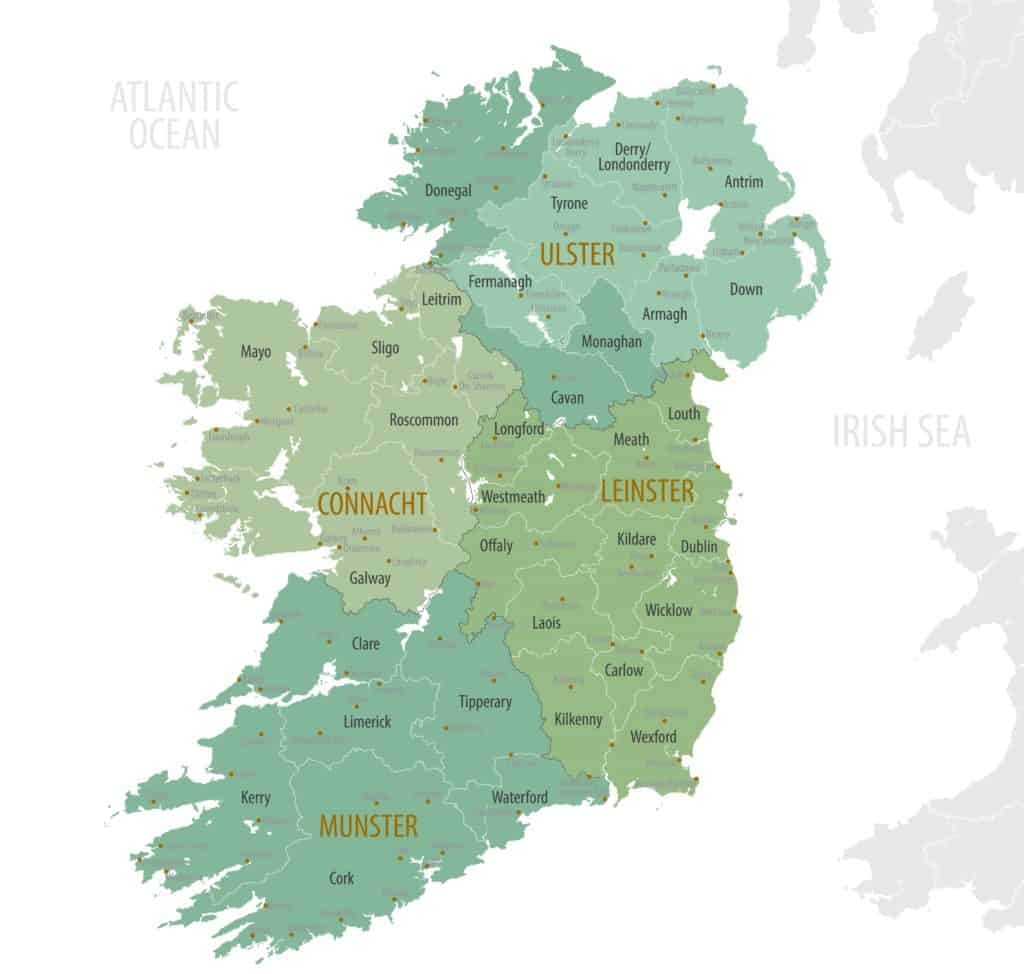
Etymology of the Four Provinces of Ireland
- Connacht / Connaught: Connacht is the English derivation of Connachta (descendants of Conn) and later Cúige Chonnact (Province of Connacht). Cúige literally means a ‘fifth’, originally there were five provinces in Ireland, including the four provinces we use today and a fifth province which was called Meath. Connacht derives from the dynasty of Conn, a mythical king of the Hundred Battles.
- Ulster: Ulster is known as Ulaidh or Cúige Uladh. Ulsters name derives from the Ulaidh, a tribe that occupied the northern part of Ireland. It was also known as Ulazitr by the Norse. Tír is the Irish for ‘land’ so this literally means, land of the Ulaid.
- Leinster: Leinster also known as Laighin or Cúige Laighean has a similar origin in terms of its name to Ulster. Leinster derives from two words, Laigin the major tribe who occupied that part of Ireland and tír, directly translating to land of the Laigin tribe. The province once comprised of the ancient kingdoms of Meath, Leinster and Osraige (modern day county Kilkenny and west Laois)
- Munster: Munster, an Mhuhain or Cúige Mumhan is the southern most province of Ireland. Mumhan means the tribe or land of Mumha.
Ulster
6 of the 9 counties of Ulster are part of Northern Ireland. They are listed Below.
Antrim – Aontroim
Beginning our list of county names is the county home to the Giants Causeway; known as Antrim or Aontroim in Irish. Aontroim means ‘lone ridge’ in English
Further speculating the origin of this name, we could compare the lone ridge to the Antrim Plateau. The Antrim Plateau is part of a broad band of basalt that stretches across Co. Antrim. A ridge in geographical terms is a chain of raised hill or mountains, so it is quite possible that Antrim’s name has derived from the Plateau.
Things to do in Antrim: Why not visit the Giants Causeway, one of Irelands most famous locations! Or explore Ireland’s world renowned Titanic museum when you’re in Belfast City.
Armagh – Ard Mhaca
Ard Mhaca means Macha’s height. Macha is an Irish Celtic Goddess associated with Ulster and Armagh.
Macha was a prominent member of Ireland’s most ancient supernatural race, the Tuatha de Danann. She was a fascinating Goddess of war, sovereignty, land and nourishment. She was one of the Goddess three, alongside the Morrigan and the Badb; sisters and Goddesses of war. Macha could transform into animals like her sister the Morrigan who would fly over battles as a crow.
The most famous story of Macha involves her transforming into a horse and winning a horse race. She was pregnant at the time, giving birth to twins thereafter.
Did you know? Armagh is known as the ecclesiastical capital of Ireland, due to the fact that Saint Patrick built his first church there. It would become the religious centre of Catholic Ireland due to his contributions.
Things to do in Armagh: Visit Saint Patrick’s Cathedral and enjoy the serenity while appreciating the stained glass windows and mosaics.
Derry / Londonderry – Doire
Doire means ‘Oak Wood’, believed to have originated from Daire Coluimb Chille which translates to ‘the Oak-wood of Calgach’. Calgah may have been Calgacus, the first Caledonian to be recorded in history.
In 1613 Derry town was rebuilt across the River Foyle from its previous site. At this time the prefix ‘London’ was added as livery companies in the City of London had donated money to the English and Scottish settlers who colonised the site.
At this time the County of Derry / Londonderry was also formed. Where the county now stands was previously the territory of County Coleraine which derives from Cúil Raithin, meaning ‘Nook of the Ferns’. Coleraine is still the name of the a town in the county.
Things to do in Derry / Londonderry: Explore the Derry City Walls. Derry / Londonderry is the only remaining completely walled city in Ireland; the 17th century construction is a fine example of a walled city in Europe.
Down – An Dún
Dún is derived from Dún ná Lethglas, the capital of Dál Fiatach, now modern day Downpatrick. The Dál Fiatach was the name of a tribe and the location they occupied in Ireland. It was a part of the Ulaid, a region which is now parts of modern day Antrim, Down and Armagh.
The Dál Fiatach were a tribe who existed primarily during the Ulster Cycle. Irish Mythology is broken up into four cycles; the Mythological Cycle, Ulster Cycle, Fenian Cycle and Kings Cycle. The Ulster Cycle focuses on the stories of battles and warriors, and include famous tales such as the Cattle Raid of Cooley and Deirdre of the Sorrows. You can learn more about the Ulster Cycle by reading our article on the Irish mythological cycles.
Things to do in Down: Relax at the seaside town of Bangor.
Fermanagh – Fear Manach
The literal translation of Fear Manach is ‘The Men of Manach’. Manach is thought to be a derivative of the old Irish saying Magh Eanagh or ‘country of the lakes’.
Lough Erne is comprised of two interconnected lakes in Fermanagh. The Lower Lough Erne is the largest lake in Fermanagh and the fourth largest lake in Ireland.
Boa island is located on the north coast of lower lough Erne. Boa derives from Badbh, another Celtic goddess and one of the three war goddesses of the Tuatha de Danann.
Two enigmatic stone figures are found in the graveyard on the island, dating back to pagan times. They have been named Janus and the Lustymore island figures.
Things to do in Fermanagh: Visit the Marble Arch Caves, a UNESCO Global Geopark
Tyrone – Tír Eoghain
The literal meaning of Tír Eoghain is ‘the land of Eoghan’.
Eoghan is believed to be the King Eoghan mac Néill. The surname ‘Mac Néill’ means son of Niall. Surnames in Irish were traditionally patronymic, that is to say based on the given name of a previous male ancestor. King Eoghan was the son of King Niall of the nine hostages.
Eógan founded the Kingdom of Ailech, which eventually became Tyrone.
Things to do in Tyrone: Visit the Ulster American Folk Park
The 3 counties of Ulster that are part of the Republic of Ireland are listed below.
Cavan – An Cabhán
An Cabhán translates to ‘the hollow’ in English. A hollow is a small sheltered valley usually containing water.
Things to do in Cavan: A relaxing 6km walk in Ballyconnell’s Canal loop.
Donegal – Dún na nGall
Dún na nGall translates to the ‘stronghold of the foreigners/strangers’. The ‘foreigners’ mentioned are thought to be the Vikings
Another name for the county in Irish is Tyrconnell or Tirconnell, a Gaelic territory which means the ‘land of Conall’. Conall is an Irish name and means ‘strong wolf’.
The Conall in question is Conall Gulban, another son of Niall of the Nine Hostages.
Things to do in Donegal: Visit Malin Head, the most northerly point of mainland Ireland.
Monaghan – Muineachán
Muineachán is composed of a few Irish words. Firstly, muine meaning ‘brake’ or ‘hillock’, which is a thickly overgrown area of small hills. Another word is acháin, meaning ‘field’.
So considering these meanings, Muineachán means hilly or bushy field. Of course nowadays the majority of forests in Ireland are long gone as our ancestors cleared the way for farms, towns and industrial buildings, but it is still interesting to think about the dense forests that once occupied 80% of the country.
Things to do in Monaghan: Visit Rossmore Forest Park
Leinster
Carlow – Ceatharlach
Ceatharlach translates to ‘place of cattle’. Fittingly, to this day Carlow is a rich agricultural county with land suitable for farming animals as well as tillage and producing quality crops.
Things to do in Carlow: Enjoy the view from the top of the Blackstairs Mountain
Dublin – mBaile Átha Cliath / Duibhlinn
Duibhlinn means ‘black pool’, while mBaile Átha Cliath, the primary Irish name of the county and capital city of Ireland means ‘town of the hurdled ford’.
A ford is a shallow place in a river or stream where one can walk across. The City of Dublin is over 1,000 years old. Originally Vikings enclosed the town with wooden stakes (which were eventually replaced with stone walls) so the name is very fitting.
A large pool used to exist at the junction of the River Liffey and the River Poddle. Due to peat staining, the pool appeared dark and it is believed that this is the reason that the Vikings gave it the name it still uses today.
Things to do in Dublin: Tour the Guinness factory and enjoy a pint from the Skyline Bar.
Kildare – Cill Dara
Cill Dara translates to the ‘church of the oak’. Saint Brigid, Irelands patron saint, who features in Irish mythology and is sometimes thought to be a version of the pagan Goddess Brigit, was from Kildare.
Things to do in Kildare: Visit St. Brigid’s Cathedral or discover the Newbridge Silverware Visitor Center & Museum of Style Icons
Kilkenny – Cill Chainnigh
Cill Chainnigh or the church of Cainneach is named after Saint Cainneach, who is believed to have converted the county of Kilkenny to Christianity. He was one of the twelve apostles of Ireland.
Pictured below is St. Canice’s Cathedral in Kilkenny
Things to do in Kilkenny: Visit the Medieval Mile Museum.
Laois
Laois derives from the Gaelic territory of Uí Laoighis or the ‘people of Lugaid Laígne’. Lugaid is a name which derives from the Celtic God Lugh.
Laois was originally called ‘Queen’s county’ after Queen Mary who created the county in 1556. After the creation of the Irish Free State, it was given its current name.
Things to do in Laois: Visit the Rock of Dunamase
Longford – An Longfort
‘An Longfort’ translates to ‘the port’. The name derived from Irish chroniclers to describe a Viking ship enclosure or fortress.
Historically, Longford was part of the ancient Meath kingdom and province. It was split off from Co. Westmeath in 1586.
Louth – Lú
Lú is a modern version of the name Lugh. Lugh Lamhfhada (Lugh of the Longarm, a nod to his fondness of spear throwing) was another Celtic deity and the champion king of the Tuatha de Dannan.
Lugh possessed one of the four treasures of the Tuatha de Danann, aptly called ‘Lugh’s Spear’, one of his many magical weapons.
An interesting fact is that Lúnasa, or in old-Irish Lughnasadh is the Gaelic word for the month of August and highlights the reverence Lugh is treated with in Irish mythology.
Things to do in Longford: Center Parcs Forest Longford
Meath – an Mhí
An Mhí means ‘the middle’ in Irish
Originally called East Meath, the original name of Meath would become the common name of the county, possibly because the Hill of Tara was located in this area. The Hill of Tara was the home of the High King of Ireland.
Meath was once its own province and the place where the high kings of Ireland lived in the Hill of Tara. This ancient version of Meath occupied modern day Meath, Westmeath and Longford. It was formally divided into Meath and Westmeath in 1542.
The middle is a fitting name for Meath, the ancient kingdom was located in the centre of Ireland.
Newgrange in the Boyne valley is another ancient location of importance found in Co. Meath. On the 21st of December (also known as the winter solstice, or the shortest day of the year,) light passes through the entrance of the burial mound and illuminates the inside. New Grange is an ancient architectural marvel, built hundreds of years before the Great pyramids of Giza. The ability to illuminate the building during the solstice highlights how skilled the ancient Irish were. They had to understand engineering, maths, astronomy and have a seasonal calendar to construct the light feature in the mound.
Things to do in Meath: Enjoy the thrilling rollercoaster at Tayto Park, or venture back in time to the Hill of Tara, the location of Ireland’s ancient high kings.
Offaly – Uíbh Fhailí
Uíbh Fhailí derives from the Gaelic territory and kingdom of Uí Failghe. Uí Failghe existed from the 6th century until the death of the last king Brian mac Cathaoir O Conchobhair Failghe in 1556.
Uí Failghe was divided into Queen’s county, which is now modern day Laois as well as King’s county which is modern day Offaly. After the creation of the Irish free state, the two counties were renamed into the names we use today, and in Offaly’s case, it preserved the name of the ancient kingdom.
Things to do in Offaly: Visit the Clonmacnoise monastery, cruise down the river Shannon, or if you’re in Offaly in August enjoy the festivities during the Tullamore show.
Westmeath – An Iarmhí
Literally means ‘west middle’ in Irish. Shares a similar story to county Meath in terms of its origin.
Things to do in Westmeath: Take a Viking tour down the River Shannon or visit athlone castle.
Wexford – Loch Garman
Loch Garman translates to the ‘lake of Garman’. Garman Garbh was a legendary character who drowned in the mudflats at the mouth of the river Slaney by an enchantress, creating the lake itself.
The name Wexford has Norse origins and means ‘fjord of the mud flats’.
Things to do in Wexford Visit Hook’s Lighthouse, the oldest working lighthouse in the world!
Wicklow – Cill Mhantáin
Cill Mhantáin means the ‘church of Mantan’. Mantan was a fellow peer of saint Patrick, his name means ‘toothless one’ as the legend goes that his teeth were knocked out by pagans.
Wicklow itself is another Norse term that means ‘meadow of the Vikings’
Things to do in Wicklow: Climb the Wicklow Mountains, Visit Glendalough or relax at Bray.
Munster
Clare – An Clár
The literal translation of Clár is ‘plain’. Clare may also have latin roots in the word ‘clear’.
Before Clare was estabhlished as a County, the region was called County Thomond, or an Tuamhain in Irish, which derived from Tuadhmhumhain meaning North Munster.
Things to do in Clare: Visit the seaside town of Kilkee, explore the Burren and bask in the breath taking Cliffs of Moher.
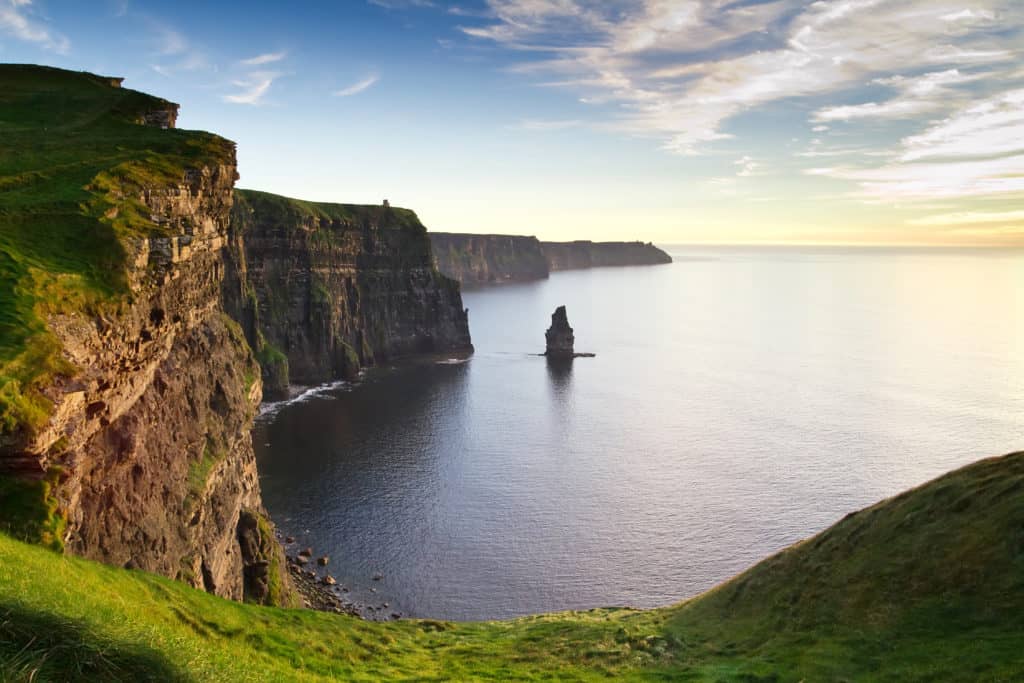
Cork – Corcaigh
Corcaigh derived from the word Corcach, which means ‘swamp’ in Irish.
Things to do in Cork: Kiss the Blarney Stone for the gift of the gab.
Kerry – Ciarraí
Home of Ireland’s tallest mountain Carrauntoohill, Ciarraí derives from two words, Ciar and Raighe, meaning ‘People of Ciar’. Ciar mac Fergus was the son of Fergus mac Róich the ex King of Ulster and Queen Meabh of Connacht, major charcters in Irish folklore and the Ulster cycle.
Things to do in Kerry: Hike Carauntoohil, the highest mountain in Ireland, visit Skellig Michael a real life Star Wars location and ancient island or attend Ireland’s oldest festival, the Puck Fair.
Limerick – Luimneach
Luimneach means ‘bare spot’, the Vikings and their own meaning which was the ‘mighty noise’.
Things to do in Limerick: Visit King John’s Castle, one of the best preserved 13th century Norman castles in Europe.
Tipperary – Tiobraid Árann
Tiobraid Árann means ‘well of the Arra’. The Arra mountains are found in Tipperary.
Things to do in Tipperary: Climb the Devils Loop or Galtee Mountains
Waterford – Port Láirge
Port Láirge means ‘Larag’s Port’.
Things to do in Waterford: Visit Waterford City, Ireland’s Oldest City founded by the Vikings over 1000 years ago.
Connacht
Galway – Gaillimh
Gaillimh, was named after the river Gaillimh, and literally means Stoney in English. Galway was previously known as Dún Bhun na Gaillimhe, which means ‘stronghold at the mouth of the Gaillimh’
Things to do in Galway: Visit Salthill or if you’re in the City in July, enjoy the Arts festival and Galway Races
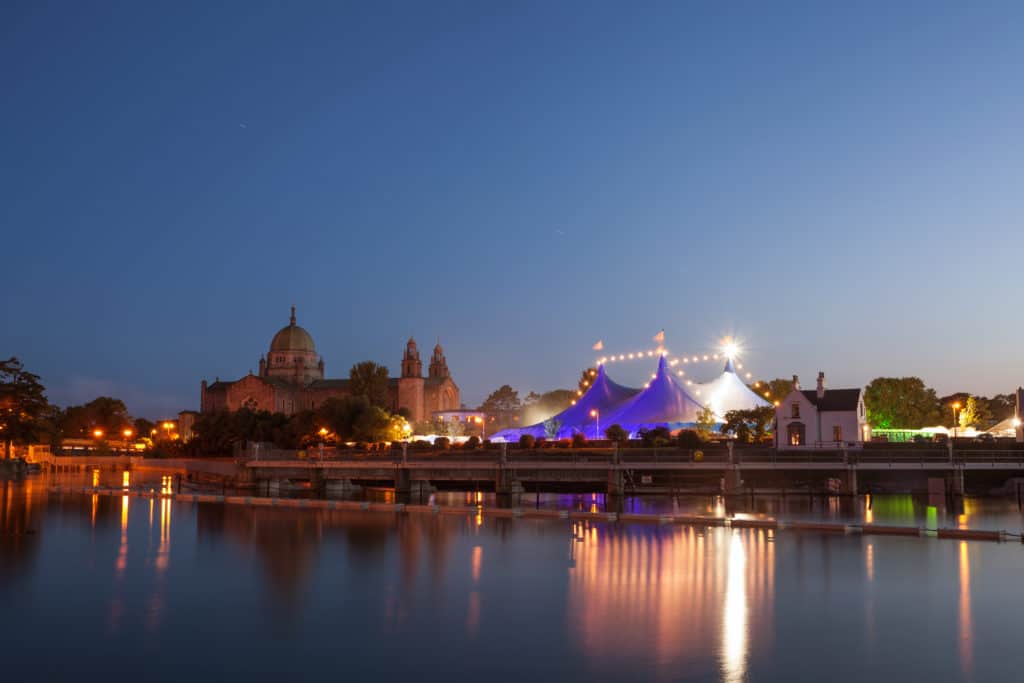
Leitrim – Liath Drum
Liath Drum means ‘grey ridge’.
Historically Leitrim was part of the Breifne Kingdom ruled by the Ó Ruairc family. The county is named after the town of Leitrim along the river Shannon.
Historically towns were built along rivers and were important strongholds against intruders. The river provided food, transport and protection for ancient dwellers and over time these strongholds became prosperous towns and cities.
Things to do in Leitrim: Visit Fowley’s Falls, Rossinver
Mayo – Maigh Eo
Maigh Eo means ‘plain of the yew’ which is literally a plain of yew trees.
Things to do in Mayo: Climb Croagh Patrick in Westport
Roscommon – Ros Comáin
Ros Comáin translates to Cóman’s wood in English. Cóman refers to Saint Cóman who founded the monastery of Roscommon around 550.
The feast day of Saint Cóman is actually December 26th.
Things to do in Roscommon: Visit Lough Key Forest Parkour Bay Sports, Ireland’s largest Inflatable Waterpark
Sligo – Sligeach
‘Shelly Place’ or Sligeach got its name due to the large amounts of Shellfish found in the River Garavogue or the Sligeach River.
Things to do in Sligo: Visit Lissadell House, home of Countess Markievicz and holiday retreat of brothers poet/writer William and artist Jack Butler Yeats
Have you enjoyed learning about the origin of Irish placenames? Which do you think is the most interesting? Let us know in the comments below!
Why not browse some of our other articles about Ireland such as:
The 20 Best Things to do in County Galway | 8 Things to do in Downings Donegal | The Giants Causeway | The most Unique Places to stay in Ireland


